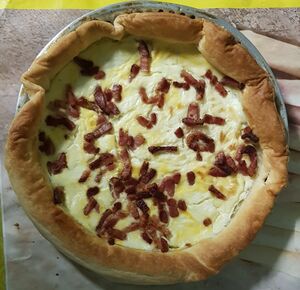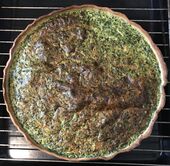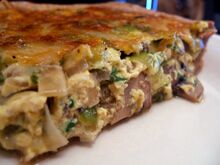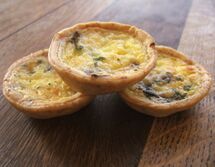كيش (أكلة)
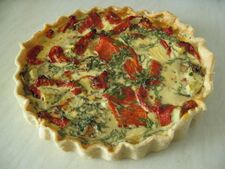 A typical quiche | |
| Type | Tart |
|---|---|
| Place of origin | France |
| Main ingredients | Pastry case filled with egg and cheese, meat, seafood, or vegetables |
| |
Quiche ( /ˈkiːʃ/ KEESH) is a French tart consisting of pastry crust filled with savoury custard and pieces of cheese, meat, seafood or vegetables. A well-known variant is quiche Lorraine, which includes lardons or bacon. Quiche may be served hot, warm or cold.
Overview
Etymology
The word is first attested in French in 1805, and in 1605 in Lorrain patois. The first English usage—"quiche Lorraine"—was recorded in 1925. The further etymology is uncertain but it may be related to the German Kuchen meaning "cake" or "tart".[1]
History
Quiche is a French dish originating from the eastern part of the country; however, using eggs and cream in pastry has a wider history. It was practised in English cuisine at least as early as the 14th century and Italian cuisine at least as early as the 13th century.[3] Recipes for eggs and cream baked in pastry containing meat, fish and fruit are referred to Crustardes of flesh and Crustade in the 14th-century The Forme of Cury[4] and in 15th-century cookbooks, such as the Italian Libro de arte coquinaria.[5]
Varieties
A quiche usually has a pastry crust and a filling of eggs and milk and/or cream. It may be made with vegetables, meat or seafood, and be served hot, warm or cold.[6][7] Types of quiche include:
| Name | Main ingredients | Ref |
|---|---|---|
| Quiche au Camembert | Camembert cheese, cream, eggs | [8] |
| Quiche aux champignons | mushrooms, cream, eggs | [9] |
| Quiche aux endives | chicory, cream, eggs, cheese | [10] |
| Quiche aux épinards | spinach, cream, eggs | [9] |
| Quiche au fromage de Gruyère | Gruyère cheese, cream, eggs, bacon | [11] |
| Quiche aux fromage blanc | cream cheese, cream, eggs, bacon | [12] |
| Quiche aux fruits de mer | shrimp, crab or lobster, cream, eggs | [13] |
| Quiche aux oignons | onions, cream, eggs, cheese | [14] |
| Quiche aux poireaux | leeks, cream, eggs, cheese | [10] |
| Quiche au Roquefort | Roquefort cheese, cream, eggs | [8] |
| Quiche comtoise | Comté cheese, cream, eggs, smoked bacon | [15] |
| Quiche Lorraine | cream, eggs, bacon[n 1] | [11] |
| Quiche niçoise, à la tomate | anchovies, olives, tomatoes, eggs, Parmesan cheese | [8] |
In her French Country Cooking (1951), Elizabeth David gives a recipe for a quiche aux pommes de terre, in which the case is made not from shortcrust but from mashed potato, flour and butter; the filling is cream, Gruyère and garlic.[16]
Gallery
Notes
References
- ^ "quiche" Archived 2020-02-21 at the Wayback Machine, Oxford English Dictionary, OUP 2015. Accessed 4 February 2016; "Quiche", Centre Nationale de Ressources Textuelles et Lexicales. Accessed 12 February 2015. This source also notes the first reference to 1805, in J.-J. Lionnois, Hist. des villes vieille et neuve de Nancy..., Nancy, t. 1, p. 80
- ^ Peterson, p. 153
- ^ "Storia origine delle torte salate". Italian Academy of Gastronomy. Archived from the original on 2017-08-08. Retrieved 2017-08-08.
- ^ Hieatt, Constance; Butler, Sharon (1985). Curye on Inglysch: English culinary manuscripts of the fourteenth century (including the forme of cury. SS. Vol. 8. London: EETS.
- ^ "Ancient Italian Cookbook" (PDF). Italophiles.com. Archived (PDF) from the original on 2 June 2016. Retrieved 5 December 2019. Austin, Thomas, ed. Two Fifteenth-Century Cookery Books. London, EETS OS 91, 1888, repr. 1964.
- ^ David (2008), pp. 18 and 187
- ^ Beck et al, p. 153
- ^ أ ب ت Beck et al, p. 155
- ^ أ ب Beck et al, p. 160
- ^ أ ب Beck et al, p. 159
- ^ أ ب Beck et al, p. 154
- ^ أ ب David (2008), p. 187
- ^ Beck et al, p. 156
- ^ Beck et al, p. 157
- ^ Montagné, p. 430
- ^ David (1999), p. 285
Sources
- Beck, Simone; Louisette Bertholle; Julia Child (2012) [1961]. Mastering the Art of French Cooking, Volume One. London: Particular. ISBN 978-0-241-95339-6.
- David, Elizabeth (1999) [1950, 1951, 1955]. Elizabeth David Classics – Mediterranean Food; French Country Cooking; Summer Food (second ed.). London: Grub Street. ISBN 1-902304-27-6.
- David, Elizabeth (2008) [1960]. French Provincial Cooking. London: Folio Society. OCLC 809349711.
- Montagné, Prosper (1976). Larousse gastronomique. London: Hamlyn. OCLC 1285641881.
- Peterson, James (2002). Glorious French Food: A Fresh Approach to the Classics. New York: Wiley. ISBN 978-0-471-44276-9.
